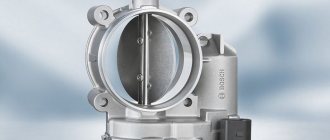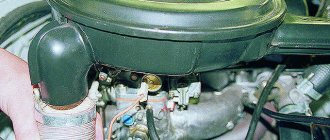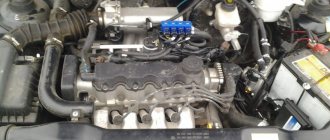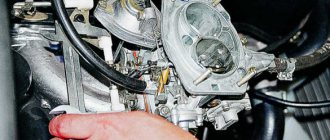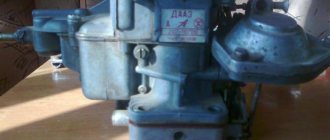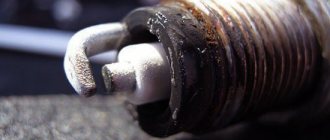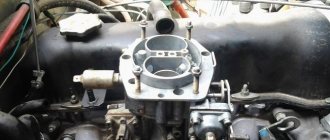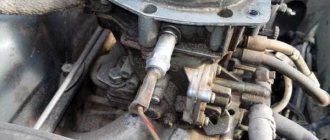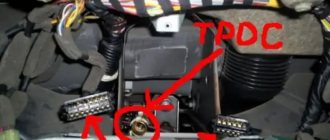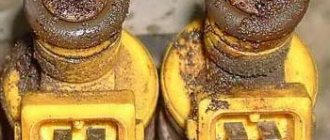Signs of failure in the fuel system
The presence of possible malfunctions in the operation of the vehicle’s power system can be judged by the characteristic signs of the vehicle’s behavior on the road:
- Failure - while pressing the gas pedal, the car continues to move at the same speed (or deceleration) for a short period of time (from 1 to 30 seconds), and only after a while begins to pick up speed;
- A jerk is reminiscent of a failure, but it is more short-lived;
- Rocking - periodic failures;
- Twitching is several jerks that follow each other;
- Sluggish acceleration is a reduced rate of increase in vehicle speed.
In addition, you can judge the presence of malfunctions in the engine power supply system by the following signs:
- Increased fuel consumption;
- The engine does not start;
- Idle speed is reduced or increased;
- Difficulty in starting a hot/cold engine;
- Difficult operation of the car engine in cold mode.
Shift in gas distribution phases, wear on the camshaft cams, incorrect adjustment of heat clearances, reduced or uneven compression in the cylinders, as well as burnt valves significantly reduce the vehicle’s power, cause vibration and increase fuel consumption.
The carburetor and its malfunctions also play an important role. Let's look at the most common carburetor malfunctions using Solex as an example. How to properly clean, check and adjust the carburetor, using the VAZ 2109 as an example, is described in the article. So.
If the cylinder-piston group is worn out, then crankcase gases, oil vapors and tarry substances can enter the carburetor area, clog the filter element of the filter, and also settle on the jets and other elements of the carburetor, thereby disrupting the operation of the engine.
Typical carburetor malfunctions
_If the engine does not start or stalls immediately after starting._ This may be due to the fact that there is no fuel in the float chamber or the composition of the mixture is incorrect (for example, the mixture is too rich or vice versa).
_The engine idles unstable or regularly stalls._ If other carburetor systems are functioning properly, more details, malfunctions are possible due to the following factors:
- Clogged channels or idle jets;
- Malfunction of the solenoid valve;
- Malfunctions in the operation of EPHH elements and the control unit;
- Malfunctions and deformation of the rubber sealing ring - a “quality” screw.
Since the transition system of the first chamber interacts with the cold running system, at incomplete speeds, failure, and sometimes even a complete stop of the engine, is possible during the smooth start of the car. By flushing or blowing out the channels, the blockage can be eliminated, but it will be necessary to partially disassemble it. It is also necessary to replace faulty parts.
Failure during acceleration of VAZ 2109 carburetor
It all started with the fact that the speed fluctuated xx.
The car did not stall only on the choke. I removed the terminal from the solenoid valve - the car did not stall. Well, everything is clear, this emc is dead. Moreover, when putting the terminal back on, there was no click. I went for a new emc. I bought the same thin one ((in a red package, yeah), tightened it by hand, then tightened it a little with a wrench, as the instructions say. xx became normal. But for some reason there was a failure during acceleration. And if you press the gas lightly, that failure no (or maybe you don’t feel it that much). If it’s a little stronger, it nods, and then it starts to go. And in 3rd-4th gear I don’t feel this. Pulling the choke doesn’t have any effect, there’s still a failure. I thought that the EMC was defective I got caught. I went, bought another one of the same kind, changed it - in my opinion, the tugging became even stronger. Although when you remove the terminal from the EMC, it stalls after 1-2 seconds as expected. Where should I dig? The hall sensor cannot give such an effect? Eephh? Still EMC ?
z.y. I’ll say right away that a couple of months ago I cleaned the carb, installed a repair kit, changed the switch wiring, switch, coil, high voltage wires, hall sensor.
There are similar topics on pelvic forums, but I haven’t come across exactly the same case.
It all started with the fact that the speed fluctuated xx. The car did not stall only on the choke. I removed the terminal from the solenoid valve - the car did not stall. Well, everything is clear, this emc is dead. Moreover, when putting the terminal back on, there was no click. I went for a new emc. I bought the same thin one ((in a red package, yeah), tightened it by hand, then tightened it a little with a wrench, as the instructions say. xx became normal. But for some reason there was a failure during acceleration. And if you press the gas lightly, that failure no (or maybe you don’t feel it that much). If it’s a little stronger, it nods, and then it starts to go. And in 3rd-4th gear I don’t feel this. Pulling the choke doesn’t have any effect, there’s still a failure. I thought that the EMC was defective I got caught. I went, bought another one of the same kind, changed it - in my opinion it began to jerk even stronger. Although when you remove the terminal from the EMC it stalls after 1-2 seconds as expected.
where to dig? Can't a hall sensor have this effect? ehhh? emk?
z.y. I’ll say right away that a couple of months ago I cleaned the carb, installed a repair kit, changed the switch wiring, switch, coil, high voltage wires, hall sensor.
There are similar topics on pelvic forums, but I haven’t come across exactly the same case.
Difficulty starting the engine and fuel consumption
_Difficulty starting a cold engine_ can be caused by incorrect adjustment of the starting mechanism. Partially closing the air damper can cause the mixture to become leaner, which in turn will cause a lack of sparks in the cylinders, and opening it incorrectly after starting the engine enriches the mixture quite richly, so the engine “chokes.”
_Difficulty starting a car when the engine is warm_ can be caused by the fact that a rich mixture enters the cylinders due to the high level of fuel that is in the float chamber. The reason for this may be a maladjustment of the fuel chamber or the fuel valve is not sealed well enough.
A little about the Solex carburetor
Initially, VAZ equipped its cars with carburetors of the Weber family. These carburetors were completely mechanized. They lacked any electrical wiring and were not very reliable. Practically, they constantly needed attention, since the main struggle of car owners was aimed at returning the engine to idle speed. Only rear-wheel drive cars of the Zhiguli family VAZ 2101, 2103 and 2106 of the early versions were equipped with it.
“Weber” was replaced by “Ozone”, which began to be successfully used on VAZ 2105-07 cars. It was a perfect design, which was equipped with idle economizers and an autonomous system. The idle problem has been resolved. Ozone was also used on Niva cars.
With the advent of the front-wheel drive VAZ 2108 on the assembly line, a perfect design was required, aimed at reducing exhaust toxicity and maximizing fuel economy. This is how Solex was born.
Initially, it was a French design, which was purchased under license and was successfully installed not only on Samaras, but also on Zhigulis. Its design took into account all the mistakes of previous units, and efficiency increased to the limit. A properly tuned mechanism lasts a long time, and maintenance and repairs are cheaper than many modern cars. Unlike the Ozone family, it uses a long rod drive or cable, which significantly softens the accelerator pedal when depressed.
Almost all domestic carburetors are called DAAZ, and an index is written through a dash, the beginning of which corresponds to the car model.
Why do dips appear when you press the gas sharply?
Classification of failures on the Solex 21083 carburetor:
- Short dip - the car does not respond to the gas pedal for about 2-3 seconds;
- Deep failure - the car does not respond to the pedal for about 10 seconds, sometimes stalls;
- Jerking – The car jerks every second and as the speed increases, the jerking stops.
Before considering the carburetor problem, it is necessary to remember that this can be influenced by a contaminated power system (air filter, fuel hoses and fine filter), as well as an ignition system that is not configured correctly. If you are sure that their operation is correct, then you can conclude that the carburetor is faulty.
The phenomenon itself may be due to a lean or too rich mixture that enters the cylinders. Further diagnostics depend on the symptoms of the malfunction and the problem can be eliminated at the lowest cost.
Dips on a carburetor car
First, let's look at the VAZ-2107 car, which has a carburetor power system.
In most cases, the occurrence of a malfunction indicates a clogged fuel system. Therefore, the first thing to check is the supply of gasoline to the carburetor.
Severe clogging of fuel lines, air leaks, and decreased performance of the fuel pump due to damaged membranes lead to the fact that an insufficient amount of fuel is supplied to the carburetor.
For example, a car starts easily and the engine runs stably at idle, but as soon as you press the gas pedal, dips appear.
If the throughput is reduced due to clogging or the pump pumps an insufficient amount of gasoline due to its malfunction or air leakage, then when the accelerator is applied, the carburetor does not supply the required portion of gasoline.
Checking the performance of the fuel pump and the capacity of the fuel lines is done by disconnecting the pipe going from the pump to the carburetor and lowering its end into a container.
Next, performance is checked using manual swapping. If the system is not clogged and the fuel pump is in perfect order, fuel should flow into the container in measured, powerful portions.
If the dosage is incorrect, the pipelines are checked for cracks and joints - air leaks can affect the normal supply of gasoline.
If everything is in order with the specified elements of the fuel system, and their operation does not cause any complaints, then the reason for the occurrence of failures lies in the carburetor.
This device provides dosed injection of fuel into the air flow passing through it and, if this dosage is violated, failures appear.
But again, you should immediately check the carburetor for air leaks. There have been cases when the fastening of the carburetor to the intake manifold became loose and a gap formed between them, through which the engine sucked in air, leaving the mixture lean.
How to eliminate dips when you press the gas sharply?
There is nothing terrible in such a phenomenon. You can fight the reasons. Why this happens depends on how the fault manifests itself. We remove unnecessary symptoms and can find out why this happens when you press the pedal.
- Short failure . It usually appears when starting to move or smoothly accelerating. In both cases, the problem manifests itself when the gas pedal is gently pressed. The problem is contamination of the first chamber of the carburetor, but it can also affect the accelerator pump. This implies the operation of all transition systems that need to be checked. It is recommended to start repairs by cleaning the carburetor.
- Jerks . They appear when operating at medium speeds and smoothly pressing the accelerator pedal. The malfunction may disappear if you press the pedal sharply. A series of sharp pressure helps to restore speed and continue driving. Here the list can be significantly expanded, namely:
- The jet located in the dosing chamber is dirty;
- The jet is not fully screwed in;
- The jet marking does not correspond to the nominal value;
- “Suction” of excess air;
- The fuel level in the float chamber is too low or the valve is stuck;
- Check the diaphragm, it may be torn.
- Deep failure at high speed at medium crankshaft speeds. Accompanied by loss of power. The car does not reach maximum speed and “freezes” at medium speeds of the carburetor engine. The list of “culprits” is as follows:
- The throttle valve of the second chamber did not open;
- The fuel system filter element is dirty;
- Economizer malfunction;
- The econostat is damaged;
- The jets are dirty or not up to specification.
How to remove and clean a Solex 21083 carburetor?
To solve the problem, you need to start by cleaning the unit, which is located under the air filter. To do this, it must be removed from the car and completely disassembled. If necessary, carry out repairs with a special kit.
To do this, you need to unscrew the nut securing the air filter cover, unfasten the cover and remove the filter element. Remove all hoses from the body and unscrew the mounting nuts from the carburetor. Next, you need to remove the body and disconnect all the damper rods from the carburetor to free it from all the holding moving elements. These include hoses.
The last step is to remove the carburetor itself. To do this, unscrew the four fastening nuts and remove the unit from the car. If this is difficult, then carefully pry it off with a thick flat-head screwdriver and generously lubricate the perimeter with WD40. It can only be removed with sudden movement.
After removal, the carburetor is completely disassembled and smoothly cleaned using kerosene, gasoline or special products for cleaning throttle valves. All elements and channels must be wiped dry, and faulty parts should be replaced with a repair kit. Now you can reassemble in reverse order, place it on the engine and fully adjust. If you have any questions about removing and cleaning the Solex 21083 carburetor, I recommend reading the review article on our website, here it is.
Marking of Solex carburetor jets
This is how problems with dips that accompany pressing the gas pedal are solved. It’s easy to guess that the problem can be solved in a garage, which is why it’s not necessary to go to a specialized service center.
